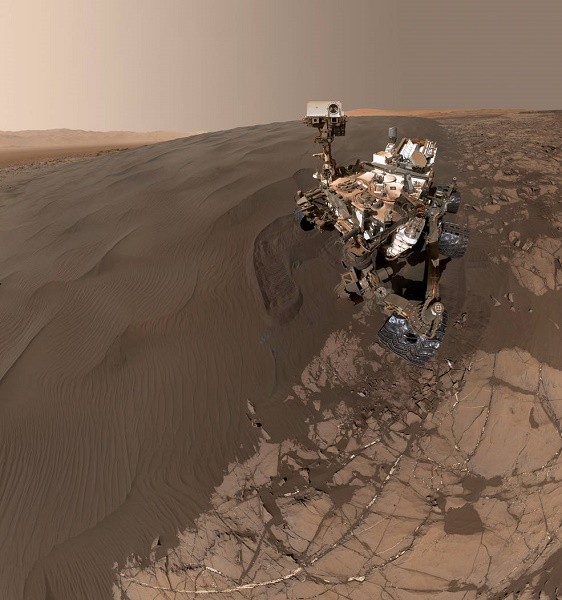Changing Seasons on Mars Revealed by NASA Curiosity Rover
| Ana Verayo | | May 15, 2016 09:41 AM EDT |
(Photo : NASA/JPL-Caltech ) NASA's Curiosity Mars rover has made measurements of Martian weather for two Mars years, since arriving there in 2012.
NASA's Mars Curiosity rover reveals the weather and environmental patterns happening on the dusty, Red Planet, as its local atmosphere shows clear skies during the winter, dustier conditions in spring and summer and windy skies during fall.
This week, Curiosity marked its second Martian year exploring the alien world, after landing and exploring the Gale Crater four years ago. One Martian year lasts 687 Earth days, which also means that this is the exact amount of days for Mars to complete its orbit around the sun.
Like Us on Facebook
According to NASA's Jet Propulsion Laboratory, measurements obtained from the Gale Crater that include temperature, air pressure, ultraviolet light and minute traces of water vapor reveal strong evidence for a repeated weather pattern, indicating changing seasons.
This has been a long time goal of Curiosity's mission, to investigate further the modern atmosphere, weather and climate for a better idea of the planet's weather billions of years ago. During that time, the Gale Crater had lakes, as groundwater would have been ideal habitats for microbes.
Even if Martian surface and terrain are now less hospitable for life, there are still dynamic environmental forces at work, according to NASA scientists. Curiosity obtained temperature measurements ranging from 15.9 degrees Celsius during summer afternoons to negative 100 degrees Celsius on winter nights.
According to NASA's Jet Propulsion Laboratory's Curiosity project scientist Ashwin Vasavada, the weather station of the rover compared measurements obtained every four hours every day, which is total to 34 million measurements so far. This duration is also crucial right now, since this is the second time that seasons are being repeated based on weather patterns.
Mars also possesses seasons like Earth since they both have similar axial tilts, providing them a yearly rhythm of weather patterns, resulting in great difference between day and night temperatures. Even when it gets warmer during the day on the surface of the Gale Crater, temperatures plummet during night to negative 90 degrees Celsius because of Mars' thin and tenuous atmosphere.
The results also show that since Mars has a more elliptical orbit than Earth, this produces extreme seasons especially in the southern hemisphere, affecting Gale Crater which is located near the equator. According to Curiosity team's German Martinez from the University of Michigan, Mars is so dry especially in the Gale Crater that its water vapor content is a thousand to less than 10,000 times on Earth.
TagsNASA curiosity rover, seasons on mars, mars exploration, Mars, weather patterns on mars
©2015 Chinatopix All rights reserved. Do not reproduce without permission
EDITOR'S PICKS
-

Did the Trump administration just announce plans for a trade war with ‘hostile’ China and Russia?
-

US Senate passes Taiwan travel bill slammed by China
-

As Yan Sihong’s family grieves, here are other Chinese students who went missing abroad. Some have never been found
-

Beijing blasts Western critics who ‘smear China’ with the term sharp power
-

China Envoy Seeks to Defuse Tensions With U.S. as a Trade War Brews
-

Singapore's Deputy PM Provides Bitcoin Vote of Confidence Amid China's Blanket Bans
-

China warns investors over risks in overseas virtual currency trading
-

Chinese government most trustworthy: survey
-

Kashima Antlers On Course For Back-To-Back Titles
MOST POPULAR
LATEST NEWS
Zhou Yongkang: China's Former Security Chief Sentenced to Life in Prison

China's former Chief of the Ministry of Public Security, Zhou Yongkang, has been given a life sentence after he was found guilty of abusing his office, bribery and deliberately ... Full Article
TRENDING STORY

China Pork Prices Expected to Stabilize As The Supplies Recover

Elephone P9000 Smartphone is now on Sale on Amazon India

There's a Big Chance Cliffhangers Won't Still Be Resolved When Grey's Anatomy Season 13 Returns

Supreme Court Ruled on Samsung vs Apple Dispute for Patent Infringement

Microsoft Surface Pro 5 Rumors and Release Date: What is the Latest?










